Treasure Planet: Special Edition
by Ben | May 4, 2003 2:52 pm
Walt Disney Feature Animation (November 27 2002), Walt Disney Home Entertainment (April 29 2003), single disc, 95 mins plus supplements, 1.66:1 anamorphic widescreen, Dolby 5.1 Surround, Rated PG, Retail: $29.99
Storyboard:
Young Jim Hawkins is your usual Disney loner, although this time around he’s living on an isolated spaceport with his Mom, who runs the Benbow Inn, a popular boarding house. One night, the inn’s landing zone is crashed onto by a dying alien pilot, who warns Jim to “beware of the cyborg”. This seemingly bolt from the blue piece of advice makes new sense to Jim after he has found a legendary treasure map on the old alien, pointing to a planet on the farthest reaches of the galaxy, and a crew has been recruited to take them there. One of the new ship mates, and someone who seems to be strangely in control of the other crew, is John Silver, part man-part robot – could this be the cyborg Jim was warned about?
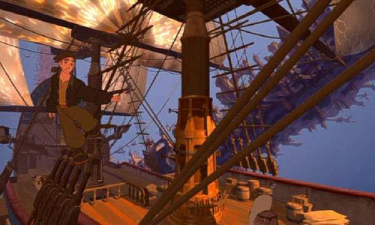
Over the course of the voyage, Silver and Hawkins become close, as Silver’s charm and persuasive nature brings a father-and-son angle to the plot: a father figure is something missing in Jim’s life and Silver soon fills this surrogate position. Jim discovers that all may not be what it seems with Silver and the rest of the crew, but it is a case of too little too late, as the cyborg has the knowledge and the alien-man power he needs to stage a mutiny. Jim’s quick thinking saves his immediate friends and their eventual escape leads them to the fabled planet, where the hidden treasure is somewhere to be found. Unknown to Hawkins and his fellow escapees, Silver’s crew is hot on their trail, and the stage is set between the two camps for a very expensive showdown, during which Jim must choose between his head and his heart, and Silver must decide whether the gold is worth dying for…
The Sweatbox Review:
Despite its underperformance at the American box office, Disney and animation fans can rest assured that in Treasure Planet, the Studio’s 43rd animated extravaganza, they will be entertained, surprised and thrilled by both the motion picture and this DVD incarnation.
Directors John Musker and Ron Clements had been trying to get their epic retelling of Robert Louis Stevenson’s Treasure Island-in-space mounted at Disney for almost 20 years. A dream project for the pair, it was first mooted as way back as production on The Black Cauldron (1985) wound down. The duo were soon at work on the Studio’s next production, The Great Mouse Detective (1986), with that film’s use of computer graphics urging the two to ask for development on their Treasure idea. Then-Disney honcho Jeffrey Katzenberg told them that no one would pay to see another Treasure Island story, especially one told in outer space, and the pair were put to work on the Studio’s big “comeback” movie The Little Mermaid (1989). Of course, that film was a smash hit, and Musker and Clements assumed that they would then be allowed to pick and choose their next project. In a way they were: Katzenberg offered them either Aladdin or The Lion King, but still no sign of a greenlight for what the two were now calling Treasure Planet.
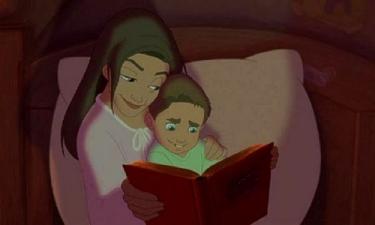
Aladdin, of course, opened to huge acclaim and even bigger box-office in 1992, and at this point Katzenberg could not very well hold the blockbuster duo back from chasing their dream project. They worked a little on developing the film during the 90s, with Katzenberg issuing them an ultimatum: deliver the Studio one last blockbuster “event” picture, and Treasure Planet has the greenlight. The two turned to Greek mythology, turning the story of Hercules on its head in 1997 with a wickedly funny musical comedy. By this time, Katzenberg had left Disney to found his own animation studio DreamWorks, although Musker and Clements remained true to their word and continued with the Hercules project, which did turn out to be another $100m hit for Disney. Although Katzenberg was gone, they did finally received their own reward: Treasure Planet was “a go”.
Perhaps the film languished in “development hell” for too long, or perhaps when the directors finally got the go ahead, it did not have enough attention paid to the story, because Treasure Planet does feel a little disjointed in places. To be fair, the screen audience really was not clambering for yet another version of Stevenson’s classic tale, and pirates were, at the time, box-office poison, so the decision to set the action in space was not only brave, but a much needed change of scenery. It works rather well, fusing the 18th Century look of the sets and costumes with the 28th Century idea of real space ships, with all the sci-fi trappings one might expect (laser cannons, turbo-powered time-warp engines, etc).

Basically the film does exactly what it sets out to do with its “Treasure Island In Space” manifesto, providing a fairly reasonable transfer of Stevenson’s book to the screen. Visually the film is stunning, with grand vistas and softly-lit characters that returns to the deep and lush style of Disney animation missing since The Hunchback Of Notre Dame and Tarzan with those wonderful settings that one could almost step in to. I did feel a tendency towards the over use of 3D computer generated backgrounds however. While put to good use in Aladdin’s trip through the Cave Of Wonders, or Hercules’ battle with Hades, in Treasure Planet the camera swirls around quite often, and the moves are not as precise as those we are accustomed to. This is obviously a directorial choice, as it does help put the audience and the chased characters in peril, but is a trick used a few times too often and coupled with the quick cuts, it can pull you out of the movie for a few moments.
Otherwise the attention to detail and the melding of 2D and 3D elements is exemplary. The ships are naturally CGI rendered, and do look as such, but somehow they do fit into this hybrid world. Props and some other characters (B.E.N. the Bio Electronic Navigator) are very well handled, and Morph, pirate Silver’s parrot-substitute is a clever addition, rendered nicely with a transparent look. Of the leads, I found Jim Hawkins to be a little stiff first time around, and I’m not sure if it was a conscious decision to make many of his and his Mother’s hand movements as similar as they are, but the subtlety works. There are moments, thanks to Joseph Gordon-Levitt’s voice acting and John Ripa’s animation, that Jim really does come alive, but these are only a few times at pivotal moments in the script, though this second viewing did open the character up to me a little more.
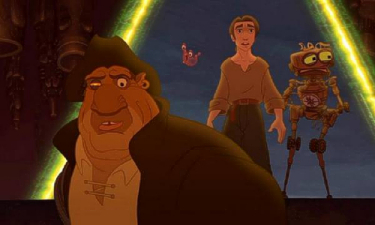
The grand experiment was John Silver’s character, here made a half-man, half-robot cyborg, with a CGI’d hand and electronic leg. What’s nice here is that his character is reflected in the making of the film in the way that, as a character he is split between right and wrong, and as a drawing he has been brought to life in two ways. For the “human” side of Silver has been traditionally hand animated by celebrated Disney animator Glen Keane (Ariel, Beast, Aladdin, Tarzan, etc) while his electronic parts have been created, match-moved and animated within the virtual CG environment. This long-way-round approach looks seamless on screen, but does create the feeling that Silver is a man of two halves, exactly the response the filmmakers were looking for. However, perhaps Keane was somehow tied to nailing a performance early on, as even Silver does not always come across with Keane’s always spot-on eye to character, and never really makes much of an impact until the point of mutiny on the ship. The father-and-son spin on the story never really catches on either, until an obviously plotted scene occurs that supposedly cements their relationship. It’s still a little labored, and the final pay off of Hawkins looking off into a Silver-tinged sky doesn’t quite have the warm-hearted feeling it should perhaps have done.
By far the most successful of the shipmates is Captain Amelia, voiced by Emma Thompson. I’m not a huge fan usually, but here is a great example of character design and voice being perfectly matched and suited to one another. You’ve never seen a better-looking cat-like alien than Amelia in those boots, I can tell you! David Hyde Pierce makes a return to the Disney fold with his turn as Dr Doppler, a weak but well-meaning father figure to young Hawkins. There’s a little twist between him and the Captain by the film’s end, but this feels like what it is: a late attempt to fit in some kind of love interest sub-plot.
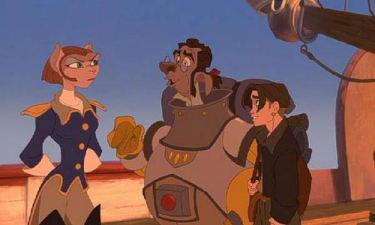
The rest of the film is all-action, with some nice set pieces and a couple of “narrative montage” songs by the Goo Goo Dolls’ John Rzeznik that do nothing to detract from the story. The inclusion of these songs is what may bring on the stronger feelings of a reminder of Fox’s animated sci-fi attempt Titan AE. But Treasure Planet never feels as squarely aimed at the teenage boys audience as Titan did. Its balance of Stevenson and Jules Verne-like elements mixes better than that film, as well as topping the Disney Studio’s own Atlantis: The Lost Empire, which Treasure Planet also vaguely resembles, mainly due to James Newton Howard’s memorably big and brassy orchestral score. If you enjoyed both Titan AE and Atlantis then you’ll go big for Treasure Planet, while its softer mix of classic adventure and the futuristic gadgetry will not put those family members off. Treasure Planet is definitely the most watchable and repeatable from this unofficial trilogy, and one that, despite its PG rating, the whole family can watch and enjoy together, which is becoming a rarer thing in this day and age.
Is This Thing Loaded?
On firing up the disc, you’ll find a star field map that serves as a menu to the options on offer. As with the Atlantis SE, there are three Navigational Platforms, which allow you to either search for the bonus treasures, discover them as you travel through the movie, or pick them purposefully from a chart, although I couldn’t notice any real discernable differences between them.
When the disc starts we’re invited to see sneak peeks at new Disney product on the way from the Studio. Also found in the menus themselves, this disc’s most anticipated trailer will be for the next animated feature Brother Bear, featuring songs from Phil Collins, some early pencil tests, production footage and a lot of great completed animation, by the looks of things. Other previews vying for attention are Finding Nemo and the DVD releases of the Atlantis and Stitch sequels, Bionicle: Mask Of Light (with the hilarious tag line “in a time…before time”), Lion King SE, the live-action George Of The Jungle 2 and Miyazaki’s Castle In The Sky.
The main menu offers us the chance to simply play the movie, choose chapter selections, view the sneak peeks again or enter set up. In Set Up you’ll find the usual language and subtitle options, as well as a THX Optimizer for adjusting your display to best show the movie. Click right of the THX logo and a hitherto invisible film clapperboard will show up, linking to credits for this DVD (and revealing the more than capable Disney team of Jeff Kurtti and Michael Pellerin are behind most of the material on offer; the DVD is also officially labelled a Special Edition here too).
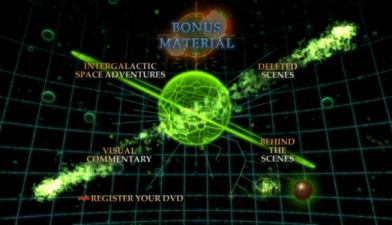
In Bonus Materials you’ll find the choice of viewing options. Most enticing first of all are the deleted scenes although these amount to little more than alternate versions of the main prologue and end sequence. The scenes are introduced by the directors and are a mixture of pencil test, storyboard and completed animation. Best of all is Jim Meets Ethan, a sweet little scene that puts the accent on Jim’s need for a father and opens his character up a lot more – a shame this was not kept in.
Intergalactic Space Adventures is the “family friendly” look at Treasure Planet’s production. The RLS Legacy (geddit – RLS?) Tour and Treasure Hunt offers a Technical and Nautical tour of the ship, as well as the disc’s only game. Presented in anamorphic widescreen, the tours are pretty nice, with newly rendered views of the ship and a narrated “walk-through” of the decks that gives the viewer enough time to take in what is being said and shown. This 11-minute look is also chopped up into 33 sub-chapters, so the viewer can always skip onto the next detail quickly. Both tours replay the same 11-minute segments, with the Technical version pointing out the way the scenes were put together and the Nautical voice over explaining the geography and purpose of each prop and machine. The Treasure Hunt game utilises portions of the tour material to lead players around the ship on the hunt for treasure (imagine that!), and though this is a good use of doubling up on footage, the game can easily become tedious. I nearly never found out what reward was given for collecting the eight map spheres, but a second attempt revealed an extra deleted scene (in final color), which was pretty much worthwhile going through the game to reach.
DisneyPedia: The Life Of A Pirate Revealed is a kids look at Pirate lore, although adults may get a kick out of guessing the names of the many films the clips come from – I noticed Blackbeard’s Ghost, Swiss Family Robinson, Pinocchio, Pocahontas, The Little Mermaid, Fantasia, In Search Of The Castaways, Sleeping Beauty, Aladdin, Ichabod And Mr Toad, Peter Pan and Treasure Island among the Disney ones, and even some early Mickey and the Pirates Of The Caribbean ride get a look in (though strangely no tie-in mention of that film)! Split into six sections, there is a “play all” feature that runs through them all, creating an 11-minute program.
Disney’s Animation Magic is our first peek behind-the-scenes, and is hosted by Roy Disney. I think what Roy has done for the Disney animation side of the company and for the company in general has been great and is too often overlooked, but his work here looks stilted and he doesn’t come across as well as Walt did on his TV show, or even Roy himself on the Snow White and Fantasia sets. That aside, this is an interesting watch for casual viewers (things don’t get too technical) as well as those who understand the process. It loses marks for the almost-comical use of the Disney’s Animation Magic ident that flashes on every time Roy mentions those three words, and for the blatant advertising of Don Hahn’s book of the same name. Also, like the documentary on the Beauty And The Beast disc, the 14-minute program is actually made up of clips from other sections of the DVD, so the viewer may bump into the same material a couple of times along the way.

Finally in this section, we have the John Rzeznik (forever to be known as “John Rzeznik of The Goo Goo Dolls”) video promo for I’m Still Here (Jim’s Theme). Presented in letterboxed widescreen, the song is as good as anything else in this style, and the clever (and expensive looking) effects-packed video is very well made, not relying on too much footage from the film as many of these clips often do, and lasts a worthwhile four or so minutes.
Back to the Bonus Features menu, and Behind The Scenes is where Disney fans and those used to the 2-disc sets will want to go. Broken down into several sub-sections, here is where the best material is. Story rather briskly gets over any mention of Stevenson’s novel, instead substituting a trailer for Walt’s 1950 live-action version of the tale. Additional storyboards and concept art for Treasure Planet can be found here, with around 27 images depicting various scenes from the movie in early form.
In Art Design, The Brandywine School (2:25) looks at the design of the film and the reasons behind the choices the production went in. The Art Galleries allow us to take a look at hundreds of development works, paintings and moments from the finished film, while The 70/30 Rule highlights the choices made by the directors in bringing a 70 per cent traditional feel and a 30 per cent futuristic style to the overall film, from the look of the ships, the design of Silver and the audiences’ perception of the use of CG in the completed movie.
The Characters is another still frame gallery, with in depth image development for several leading and secondary characters in the film. John Silver and the B.E.N. robot both have their roles explored more deeply, with additional video clips. The Hook Test shows Glen Keane’s original paring of Silver’s cyborg arm combined with another famous Disney pirate, Captain Hook, to see if the combination of traditional and CG animation within a single character was technically and emotionally feasible. CG animator Eric Daniels explains more, also providing the first test of Silver’s CG arm. For B.E.N. we get the look at the development art, as well as 3D Character/2D World, a video clip that includes early tests and the reasons behind the decision to make B.E.N. a CG character, while Maquettes (3.10) treats us to a cut-down version of a clip that first appeared on the Treasure Planet web site. It’s a very cool look at how computers also played a part in creating the statue of John Silver that aided the animators in drawing the character the same way from different angles.

Next, in Animation, we’re offered another look at The Hook Test, with the same Glen Keane intro as before. That done, a one-minute look at the design for Doppler by animator Sergio Pablos shows some early pencil tests, while Silver’s Progression Animation shows the creation of a scene by Keane, from storyboard, through rough pencil and final animation, with emphasis on showing off the blend of 2D and 3D CG enhancements. Pencil Animation offers up two more short clips, one featuring early designs of Captain Amelia, the other a rough animation (as opposed to the usual storyboards) to final film comparison.
Back in the Behind The Scenes menu, there’s another opportunity to view the same three Deleted Scenes as on the main menu. Dimensional Staging brings us to more galleries, with Color Keys up first, offering a look at the color styling for various scenes in the movie. Layout Demonstrations is another short video clip, taking us through three virtual backgrounds, and Treasure Planet Found explores the core of the title world, from rough animation and animatics, to the CG design and the thinking behind the design of the starfield map that would lead young Jim there. Lighting rounds this section up and takes a look at the use of Deep Canvas, the Studio’s virtual painting technology, and how the lighting in a scene can affect the mood and texture of what happens on screen.
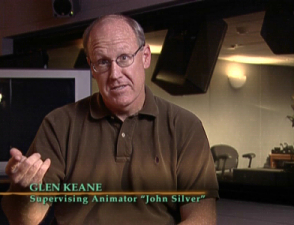
Merging 2D And 3D Worlds leads to another set of clips, both new and also available elsewhere on this disc. Pose Camera explains the process of combining a 2D hand drawn character within a 3D computer generated model, showing pencil tests, and a sequence breakdown. Effects Animation does pretty much the same thing with props environments, and both clips are straight-forward in their deliveries. It’s always nice to see this early concept stuff and it’s a shame there isn’t more, but you still get a fair share and much more than would normally be included in a half-hour “making of”. Finally, the RLS Legacy Tour and Game links to the same material as outlined earlier.
Under the Music heading, I was hoping to find something on James Newton Howard’s swashbuckling score, but the only option is to watch the John Rzeznik (of the Goo Goo Dolls) music video again. Closing the Behind-The-Scenes section is Release, which takes a brief look at the publicity for Treasure Planet. Here you’ll find the original Teaser Trailer (with that great John Williams score from Far And Away), the full Theatrical Trailer (that really does echo the ads for Titan AE) and a couple of examples of poster artwork (a minor disappointment is that the posters appear on a single page and are not able to be enlarged).
Finally, and also accessible on the main menu, is the Visual Commentary. I decided to wait and leave viewing this until last as it seemed that, as with the Atlantis disc, much of the material would be repeated. The visual commentary approach offers a new way for an audience to experience a movie and its production, but is by no means recommended to watch before you’ve seen the movie proper, as the constant interruptions break the flow of the film. Here, we’re introduced (in a very amusing clip) to directors Musker and Clements and their producer Roy Conli, who explain that during the movie the standard audio commentary will occasionally lead into a short video clip that will explain the process of creating the scene you are viewing. When the clip is done, the film will return to the exact same point it left off and the commentary will continue.

This does tend to work, but the material offered within this viewing option is made up of the featurettes seen in the various sections already explored. The commentary itself is great and the trio are occasionally joined by Keane and various crew, so there are hardly any lulls or dead audio. There is still much to learn, but clip wise you won’t find anything new (unless of course you watch the film in this way before exploring the bonus section), and although overall the idea works, I did find the placing of the John Rzeznik (of The Goo Goo Dolls) video and the Treasure Island trailer really took me out of both the film and the commentary. The insert inside the packaging mentions that the audio commentary itself cannot be selected via a menu, but can be toggled on the player’s remote to select the track separately. My standard set-top player and my computer drive did not want to do this (I also found it impossible to switch on any foreign language subtitles), so maybe it was a feature dropped at the last minute?
As for the disc itself, seemingly everything that could have been included on the DVD is here, and does a good job of preserving the film’s production.
Case Study:
Perhaps not encouraged by its lacklustre box-office takings and projections of home video success, Treasure Planet becomes the first major Disney title not to turn up in the classic white keepcases that have traditionally adorned the Studio’s releases in the past. Initial pressings will find a savings coupon booklet and Mission Space sweepstake card inside, though all copies should contain a four-page insert that lists the Bonus Features in detail.
On the back, as well as a chapter index, the insert also points out the difference between full-screen and widescreen framing. “Do you see the difference?” it asks, while also pointing out that the “black bars” are normal, and that if the viewer wants to watch the film full-screen, they should “check to see if your player is equipped with a zoom feature to simulate a full-screen image on your television”. Looks like Disney, while not wanting to alienate the full-screen brigade, is happy to start educating people on the merits of widescreen – a good step forward, though why do they always pick non-appropriate images to illustrate how much is being chopped off!?
Ink And Paint:
I originally saw Treasure Planet on its release into UK cinemas in mid-February 2003. By this time the film had been lost in the void in American theaters and plans for the much talked about Imax version of the film had been scuppered long ago. The print I saw was scratchy, and with printer marks down the right hand side throughout the entire film (I was hoping that they would disappear after the first reel, but alas they stayed). Disney really had just dumped this film, using second-hand US prints for its UK rollout, and not even bothering to check that decent versions were going out. I feel this is a real shame, as Planet deserves more than this, especially in light of its recent Oscar campaign (or lack of), which had just been announced when the film opened in the UK.
On disc, things have been rectified – it simply couldn’t look better! A crisp 1.66:1 (actually closer to 1.78) anamorphic digital transfer creates depth and hues that the film print I saw had lost long ago, with color that is rock solid. I love the deep blues that Disney (particularly the films of Musker and Clements) get into their films, and Planet has some exceptional night-time scenes to marvel at. There is so much happening in Treasure Planet that a good widescreen transfer would have been essential and I enjoyed my viewing of the film much more this second time around, noticing background elements and additional touches that were washed out in the theater – this is certainly demo quality material. English subtitles are also provided, as are French and Spanish (although they didn’t seem to work on my copy) as well as true English Closed Captions.

Scratch Tracks:
Perhaps because of its poor performance Stateside, UK theaters did not offer late-night adult-only showings of Treasure Planet, so I originally endured this with a bunch of kids at the afternoon screening I saw. What I do love about seeing films with children is the awe and wonder in their faces as they see the most amazing sights and hear the most amazing sounds. There was many a “wow” and gasp coming from the seats behind me, and my friend’s four-year-old son was transfixed. Maybe bearing in mind that this is ostensibly a kids movie, the theater sound system did not seem to me to be pumped up to its usual wattage. While this did not detract from my enjoyment of the film, I was hoping for a little more push when the big action sequences kicked in.
In my home theater the movie really came to life. The surrounds are forced into overtime as ships swirl around in the air and zoom past the listener. James Newton Howard, making somewhat of a new Disney career for himself after scoring Dinosaur, Atlantis and M. Night Shyamalan’s trio of The 6th Sense, Unbreakable and Signs for Buena Vista, again scores big (pun intended!) here, with an atmospheric and totally engrossing musical accompaniment. The disc reproduces the sound of his orchestra with a fully enveloping experience – the sound on this disc is a deep and rich as the pictures it is matched to, while not forgetting the thrills of deep bass rumbles, spacey strings, and the importance of crystal clear dialogue – first class!
Additional French and Spanish dubs are provided, with the same basic mix as their English counterpart. However, on my attempts to get the foreign subtitles to work, and in checking that the foreign dubs were intact, I noticed that although the French language version retains the Rzeznik songs in English (including Always Know Where You Are, which was covered by BB Mak on the soundtrack album), the Spanish dub features a completely different song (in Spanish) over the end credits, before Rzeznik’s song plays out right at the end instead of the original score – a “cheeky” extra for the curious!
Final Cut:
Okay, so this isn’t perhaps the all-conquering 2-disc extravaganza fans of the movie may want, but it is a very respectable special edition. This could have been worse, given Disney’s lack of support for this title after its initial box-office disappointment: we could have had a bare bones pan-and-scan only affair! That it has been given a beautiful digital widescreen transfer and commentary is fine enough, but the extra features are also more than welcome and are a better selection than, say, the single Lilo And Stitch disc. Sometimes the overlap of information given in the two-disc sets (Tarzan, Dinosaur, Emperor’s New Groove, Atlantis) is annoyingly repetitive anyhow: by now many audiences should know how an animated film is put together (“we start out with a storyboard, which is like the whole movie told as a comic strip”)! It’s actually refreshing that all that ground is not revisited here, and instead the features concentrate on the film itself rather than the technique. Everything is present and correct, and there is little reason to complain. Given Treasure Planet’s production and release history, one might have expected a distinct lack of extras. As it turns out, it couldn’t get a lot better than this!
ALSO OF NOTE: Released in some European countries is a Treasure double-box set, which includes this disc plus Walt Disney’s 1950 live-action version of the original novel, starring Robert Newton and Bobby Driscoll. That film (which comes well recommended) is also available individually [1]in the States, so completists can compare the two films for themselves.
 | ||
 [2] [2] |
- individually : http://www.amazon.com/Treasure-Island-Bobby-Driscoll/dp/B000089G5L?tag2=animatedviews-20
- [Image]: http://www.amazon.com/Treasure-Planet/dp/B00005JLR2?tag2=animatedviews-20
Source URL: https://animatedviews.com/2003/treasure-planet-special-edition/